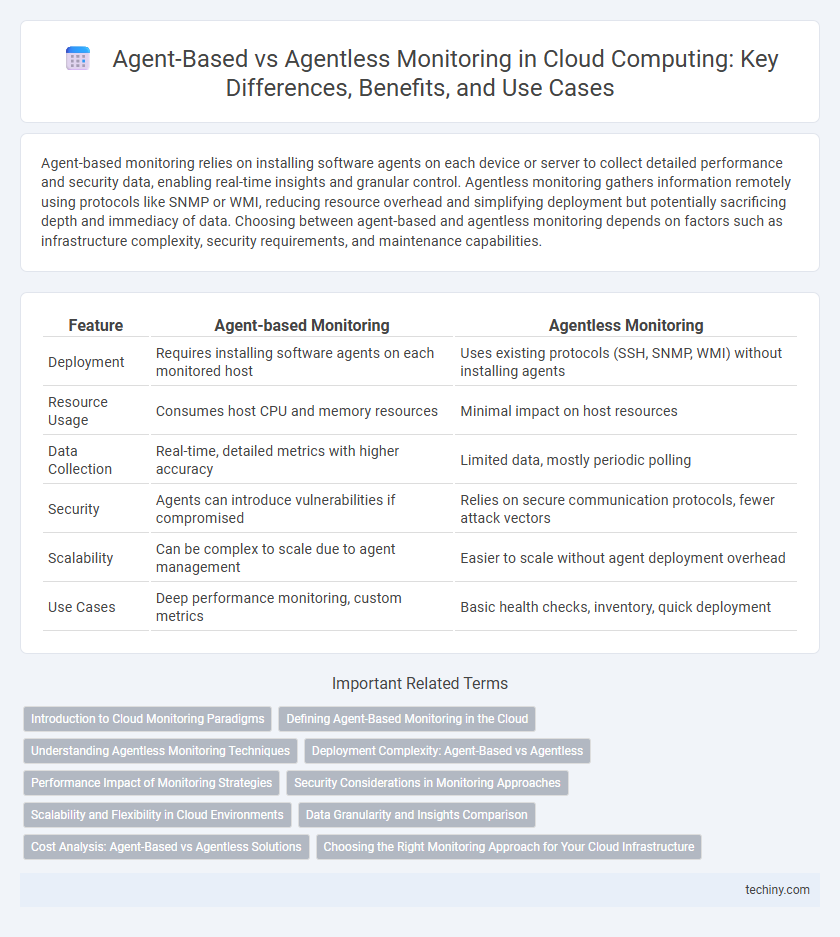Agent-based monitoring relies on installing software agents on each device or server to collect detailed performance and security data, enabling real-time insights and granular control. Agentless monitoring gathers information remotely using protocols like SNMP or WMI, reducing resource overhead and simplifying deployment but potentially sacrificing depth and immediacy of data. Choosing between agent-based and agentless monitoring depends on factors such as infrastructure complexity, security requirements, and maintenance capabilities.
Table of Comparison
| Feature | Agent-based Monitoring | Agentless Monitoring |
|---|---|---|
| Deployment | Requires installing software agents on each monitored host | Uses existing protocols (SSH, SNMP, WMI) without installing agents |
| Resource Usage | Consumes host CPU and memory resources | Minimal impact on host resources |
| Data Collection | Real-time, detailed metrics with higher accuracy | Limited data, mostly periodic polling |
| Security | Agents can introduce vulnerabilities if compromised | Relies on secure communication protocols, fewer attack vectors |
| Scalability | Can be complex to scale due to agent management | Easier to scale without agent deployment overhead |
| Use Cases | Deep performance monitoring, custom metrics | Basic health checks, inventory, quick deployment |
Introduction to Cloud Monitoring Paradigms
Agent-based monitoring in cloud computing deploys software agents on individual virtual machines or containers to collect detailed, real-time metrics and logs, enabling granular visibility into system performance and security. Agentless monitoring leverages protocols like SNMP, WMI, or APIs to gather data remotely without installing software on target devices, reducing overhead and easing deployment in dynamic cloud environments. Selecting between these paradigms depends on requirements such as data granularity, resource consumption, scalability, and security compliance within cloud infrastructure.
Defining Agent-Based Monitoring in the Cloud
Agent-based monitoring in cloud computing involves deploying dedicated software agents on each virtual machine or server to collect detailed performance metrics and system data in real time. These agents provide granular visibility into application behavior, resource utilization, and security events by interacting directly with the underlying operating system and hardware. This method enables proactive issue detection and precise troubleshooting but requires management of agent installation, updates, and potential resource overhead.
Understanding Agentless Monitoring Techniques
Agentless monitoring techniques leverage remote protocols such as SNMP, WMI, or SSH to collect performance metrics and system data without installing software on target devices, reducing overhead and deployment complexity. This approach enables centralized management across diverse infrastructure including servers, network devices, and cloud resources, while minimizing security risks associated with additional agents. Organizations benefit from scalable, real-time visibility and easier compliance with regulatory standards through automated discovery and monitoring of dynamic IT environments.
Deployment Complexity: Agent-Based vs Agentless
Agent-based monitoring requires installing and maintaining software agents on each target device, resulting in higher deployment complexity and increased resource overhead. Agentless monitoring relies on existing protocols like SNMP or WMI to collect data without installing additional software, significantly reducing deployment time and simplifying management. Organizations often choose agentless solutions for environments with diverse devices or strict security policies due to easier scalability and lower operational impact.
Performance Impact of Monitoring Strategies
Agent-based monitoring installs software directly on target systems, enabling deep visibility with detailed metrics but can introduce higher resource consumption, potentially affecting system performance. Agentless monitoring reduces resource overhead by collecting data remotely via protocols like SNMP or WMI, minimizing performance impacts but sometimes limiting the granularity and frequency of data collected. Evaluating network load, CPU usage, and memory consumption differences between these strategies is crucial for optimizing cloud infrastructure monitoring without degrading service quality.
Security Considerations in Monitoring Approaches
Agent-based monitoring installs dedicated software agents on cloud resources, enabling granular data collection and enhanced security through encrypted communication and real-time threat detection. Agentless monitoring leverages existing protocols like SNMP and WMI, reducing attack surfaces but potentially limiting visibility and delayed anomaly response. Evaluating security considerations involves balancing the comprehensive insights of agent-based systems against the lower infrastructure footprint and simpler compliance of agentless solutions.
Scalability and Flexibility in Cloud Environments
Agent-based monitoring offers enhanced scalability in cloud environments by deploying dedicated software agents on each virtual machine, enabling granular data collection and real-time analysis across dynamic workloads. Agentless monitoring improves flexibility by leveraging remote protocols and APIs to access infrastructure metrics without installing additional software, reducing overhead and simplifying deployment in hybrid and multi-cloud setups. Balancing agent-based and agentless approaches optimizes performance, allowing organizations to scale monitoring solutions while adapting to diverse cloud architectures and operational requirements.
Data Granularity and Insights Comparison
Agent-based monitoring provides granular data collection with deep system-level insights by installing software agents on individual devices, enabling real-time performance metrics and detailed anomaly detection. In contrast, agentless monitoring gathers broader data from network protocols and APIs without installation, offering less fine-grained visibility and delayed issue detection. The choice impacts the depth of operational intelligence, where agent-based approaches excel in detailed diagnostics while agentless models favor streamlined deployment and fewer resource demands.
Cost Analysis: Agent-Based vs Agentless Solutions
Agent-based monitoring requires deploying software agents on each device, leading to higher upfront and maintenance costs due to licensing and resource consumption. Agentless monitoring reduces expenses by eliminating the need for installed software, relying on remote protocols like SNMP or SSH, which lowers operational overhead. Cost efficiency depends on the scale and complexity of the cloud environment, with agentless solutions often favored for their lower total cost of ownership in dynamic or large-scale infrastructures.
Choosing the Right Monitoring Approach for Your Cloud Infrastructure
Agent-based monitoring provides in-depth visibility and granular data collection by deploying software agents on cloud resources, ideal for environments requiring detailed performance metrics and real-time alerts. Agentless monitoring offers simplified deployment and lower overhead by using APIs and remote protocols to gather data, suitable for dynamic or ephemeral cloud workloads with minimal intrusion. Selecting the right approach depends on factors like infrastructure complexity, security policies, and the need for detailed analytics versus ease of maintenance in cloud computing environments.
Agent-based Monitoring vs Agentless Monitoring Infographic

 techiny.com
techiny.com